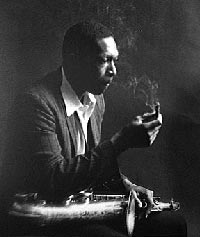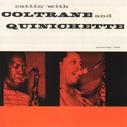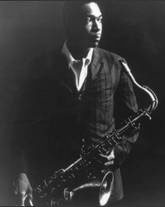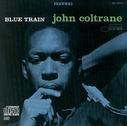
John Coltrane on Tenor at the Jazznote
Of all of Miles Davis' former sidemen John William Coltrane has carried through the decades as perhaps the greatest innovator on his chosen instrument. Interestingly, the sound that we associate with him as the 'Coltrane Sound' came relatively late in his career, and even then evolved into an almost entirely new approach by the time of his death in 1967.
Born 9/23/26 in Hamlet, North Carolina, Coltrane made his professional debut in 1945 with a cocktail combo in Philadelphia. Between 1945-46 Coltrane, still playing alto, was in a Navy band; a recording from this period (playing Parker's 'Ko-Ko') has survived. Forllowing tours with Eddie Vinson's R&B band ('47-8) made his way into Dizzy Gillespie's Big Band where he remained from 1949 to 1951, as yet leaving little impression. After stints with Earl Bostic and then Johnny Hodges, Coltrane landed a spot in the new Miles Davis Quintet formed in 1955.
Featuring Red Garland (p), Paul Chambers (b), and Philly Joe Jones (d) in addition to Coltrane, Davis' new Quintet would attract considerable attention from fellow musicians and some critics, but more for the group's successful cohesion rather than Coltrane's individual contribution. It is only with the marathon Prestige sessions that would become Workin', Relaxin', and Steamin' recorded in May 1956, and the final session for Prestige, Cookin' in October of that year, that we come to see the emergence of a tenor star. But these sessions, consisting of the quintet's entire repertoire would take nearly six years to be released in their entirety (1957-62).
1957 would be the year that Coltrane truly came into his own. Weeks before leaving Miles Davis, Coltrane released his debut as leader, Coltrane (Prestige 7105), a public inauguration of the 'sheets of sound' that would incite both acclaim and criticism in the years to follow. [Not unlike abstract painting, 'sheets of sound' was an attempt to approach a chord from various angles at once, or at least in a quick stream.] But it is for the ballads 'Violets For Your Furs' and 'While My Lady Sleeps' that Coltrane is especially noteworthy; Miles Davis would always insist that Coltrane sit out on his ballads, supposedly due to the brutality of his sax-work. But on these tracks we hear a sensitivity beautifully at odds with the more volatile arrangements (check out Sahib Shihab's violent baritone romp on the intro to 'Bakai').

 Cattin' with Coltrane and Quinichette is one of Coltrane's earlier recordings, a double-bill with the underrated tenor, Paul Quinichette. The two complement each other wonderfully on this session given Quinichette's leaning towards the Lester Young school of tenor. The CD reissue of this May 17, 1957 session augments the original five-track program with an unreleased version of "Tea For Two" sans Coltrane and the addition of three previously unreleased Quinichette Quintet tracks from a 1952 session. Just under an hour of classic bop of major historical significance this album comes highly recommended.
Cattin' with Coltrane and Quinichette is one of Coltrane's earlier recordings, a double-bill with the underrated tenor, Paul Quinichette. The two complement each other wonderfully on this session given Quinichette's leaning towards the Lester Young school of tenor. The CD reissue of this May 17, 1957 session augments the original five-track program with an unreleased version of "Tea For Two" sans Coltrane and the addition of three previously unreleased Quinichette Quintet tracks from a 1952 session. Just under an hour of classic bop of major historical significance this album comes highly recommended.
In August of that year Coltrane would record Traneing In (Prest. 7123) with the Red Garland Trio (Garland, Paul Chambers and drummer Art Taylor) in which he would contribute the titles 'Traneing In' and 'Bass Blues.' The title track, clocking in at just over 12 minutes, features some of Garland's finest piano work, while 'Bass Blues' is a fine blues run through the 'sheets of sound'. Once again, as if to send a message loud and clear to Davis he provides a fantastic performance on the ballad 'Slow Dance' with considerable help from Chambers. The penultimate track, the ballad 'You Leave me Breathless', is followed hard on with Taylor's crash-and-boom introduction to 'Soft Lights and Sweet Music'. Deceivingly titled, it is thorough up-tempo bop right until the last bar when it finally comes to a soft and sweet conclusion.
 Having left Davis' restrictive playing field Coltrane joined up with Thelonious Monk. As demanding a leader as he was difficult a composer, Monk's appreciation for the cutting edge of jazz was just what Coltrane needed to consolidate his technique. As a result those five weeks at the Five Spot in 1957 brought Coltrane yet closer to realizing his vision of sound. Fortunately for us, his wife, Juanita (Naima) Coltrane captured one late Summer performance (available from Blue Note as Thelonious Monk at the Five Spot). Though of poor sound quality this quartet recording (with Ahmed Abdul-Malik on bass, who would later appear on Coltrane's 1961 Village Vanguard performances, along with Roy Haynes on drums) is perhaps the strongest document of this historic collaboration.
Having left Davis' restrictive playing field Coltrane joined up with Thelonious Monk. As demanding a leader as he was difficult a composer, Monk's appreciation for the cutting edge of jazz was just what Coltrane needed to consolidate his technique. As a result those five weeks at the Five Spot in 1957 brought Coltrane yet closer to realizing his vision of sound. Fortunately for us, his wife, Juanita (Naima) Coltrane captured one late Summer performance (available from Blue Note as Thelonious Monk at the Five Spot). Though of poor sound quality this quartet recording (with Ahmed Abdul-Malik on bass, who would later appear on Coltrane's 1961 Village Vanguard performances, along with Roy Haynes on drums) is perhaps the strongest document of this historic collaboration.
It was also during Coltrane's short tenure with Monk that he stepped back into Van Gelder's studio in Hackensack, New Jersey, on September 15, 1957, to record perhaps his greatest performance ever.
Given permission from Prestige to lead just one album for Blue Note, Coltrane gave it his all. Collecting some material he'd penned long ago but never recorded, he was joined by Blue Note regulars such as young trumpet sensation Lee Morgan, Curtis Fuller (tmb), and Kenny Drew (p), as well as Davis-era colleagues Paul Chambers (b) and Philly Joe Jones (d).
Click here for some classic Coltrane from the title track of Blue Train. (1:23; 328 KB)
for some classic Coltrane from the title track of Blue Train. (1:23; 328 KB)
Click here for the intro to Coltrane's "Moment's Notice" for some fine ensemble interaction. (51 seconds; 203 KB)
for the intro to Coltrane's "Moment's Notice" for some fine ensemble interaction. (51 seconds; 203 KB)


 The results are nothing short of stellar. Recently rereleased by Blue Note records Blue Train is now an enhanced CD including audio interviews with such artists as Kenny Burrell, Johnny Griffin, Andrew Hill, Curtis Fuller (the last surviving musician from the session), Roy Haynes, as well as an inciteful interview with recording engineer Rudy Van Gelder with a comprehensive accompaniment of studio photos taken by Blue Note's Francis Wolff. These are especially worth close examination--see if you can see the furniture belonging to Van Gelder's parents; their living room was the original sight of the Blue Note recording studio! Also included is an essay, a video clip from a televised performance of the Miles Davis Quintet (circa 1959) performing 'So What', a brief Coltrane Blue Note discography including audio clips and album covers, along with alternate takes of 'Blue Train' and 'Lazy Bird'.
The results are nothing short of stellar. Recently rereleased by Blue Note records Blue Train is now an enhanced CD including audio interviews with such artists as Kenny Burrell, Johnny Griffin, Andrew Hill, Curtis Fuller (the last surviving musician from the session), Roy Haynes, as well as an inciteful interview with recording engineer Rudy Van Gelder with a comprehensive accompaniment of studio photos taken by Blue Note's Francis Wolff. These are especially worth close examination--see if you can see the furniture belonging to Van Gelder's parents; their living room was the original sight of the Blue Note recording studio! Also included is an essay, a video clip from a televised performance of the Miles Davis Quintet (circa 1959) performing 'So What', a brief Coltrane Blue Note discography including audio clips and album covers, along with alternate takes of 'Blue Train' and 'Lazy Bird'.
This is only the very beginning of our coverage on one jazz's most enduring legends

HOME | TOP | ARTISTS

 Cattin' with Coltrane and Quinichette is one of Coltrane's earlier recordings, a double-bill with the underrated tenor, Paul Quinichette. The two complement each other wonderfully on this session given Quinichette's leaning towards the Lester Young school of tenor. The CD reissue of this May 17, 1957 session augments the original five-track program with an unreleased version of "Tea For Two" sans Coltrane and the addition of three previously unreleased Quinichette Quintet tracks from a 1952 session. Just under an hour of classic bop of major historical significance this album comes highly recommended.
Cattin' with Coltrane and Quinichette is one of Coltrane's earlier recordings, a double-bill with the underrated tenor, Paul Quinichette. The two complement each other wonderfully on this session given Quinichette's leaning towards the Lester Young school of tenor. The CD reissue of this May 17, 1957 session augments the original five-track program with an unreleased version of "Tea For Two" sans Coltrane and the addition of three previously unreleased Quinichette Quintet tracks from a 1952 session. Just under an hour of classic bop of major historical significance this album comes highly recommended.

 Having left Davis' restrictive playing field Coltrane joined up with Thelonious Monk. As demanding a leader as he was difficult a composer, Monk's appreciation for the cutting edge of jazz was just what Coltrane needed to consolidate his technique. As a result those five weeks at the Five Spot in 1957 brought Coltrane yet closer to realizing his vision of sound. Fortunately for us, his wife, Juanita (Naima) Coltrane captured one late Summer performance (available from Blue Note as Thelonious Monk at the Five Spot). Though of poor sound quality this quartet recording (with Ahmed Abdul-Malik on bass, who would later appear on Coltrane's 1961
Having left Davis' restrictive playing field Coltrane joined up with Thelonious Monk. As demanding a leader as he was difficult a composer, Monk's appreciation for the cutting edge of jazz was just what Coltrane needed to consolidate his technique. As a result those five weeks at the Five Spot in 1957 brought Coltrane yet closer to realizing his vision of sound. Fortunately for us, his wife, Juanita (Naima) Coltrane captured one late Summer performance (available from Blue Note as Thelonious Monk at the Five Spot). Though of poor sound quality this quartet recording (with Ahmed Abdul-Malik on bass, who would later appear on Coltrane's 1961 

